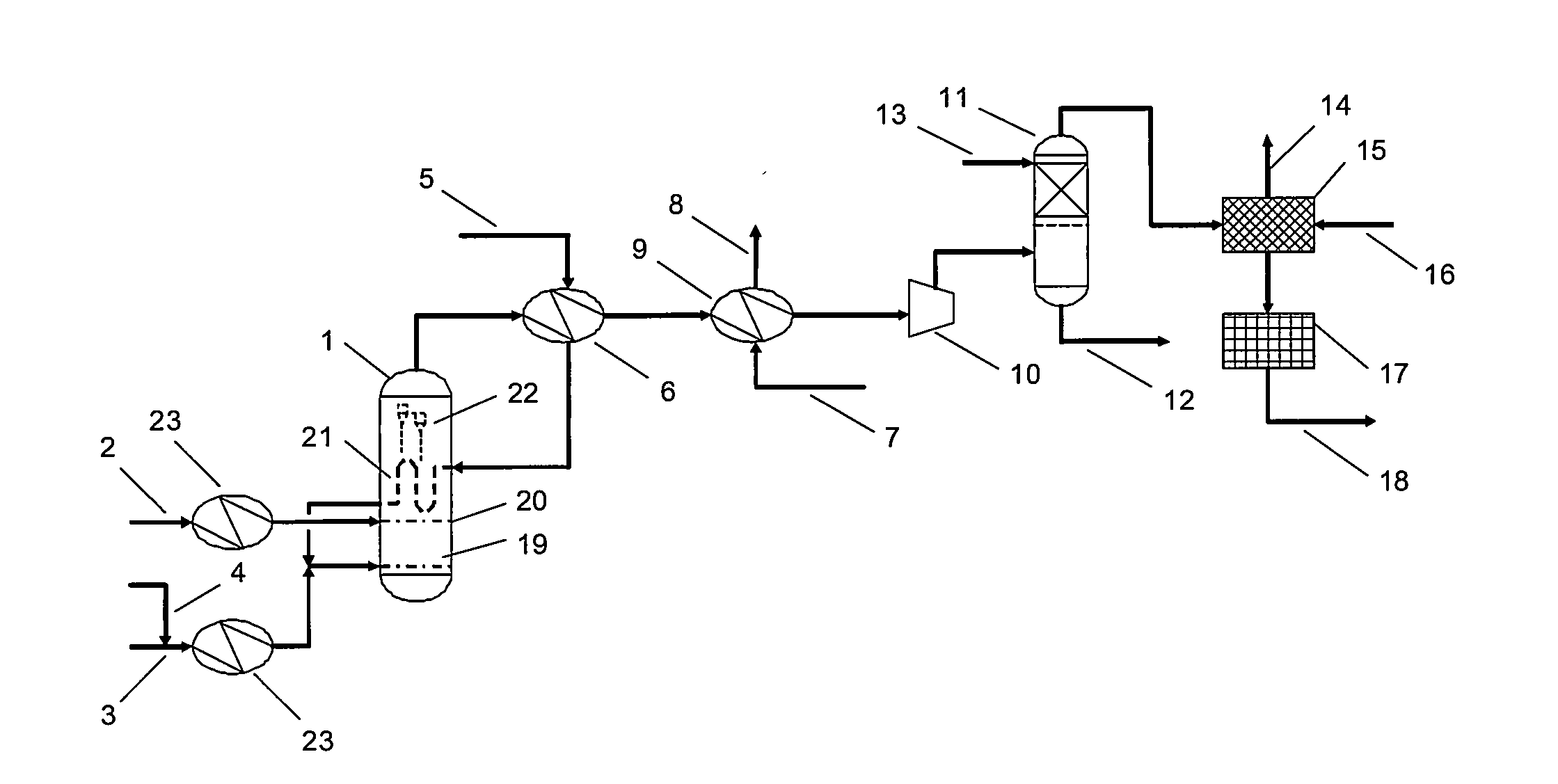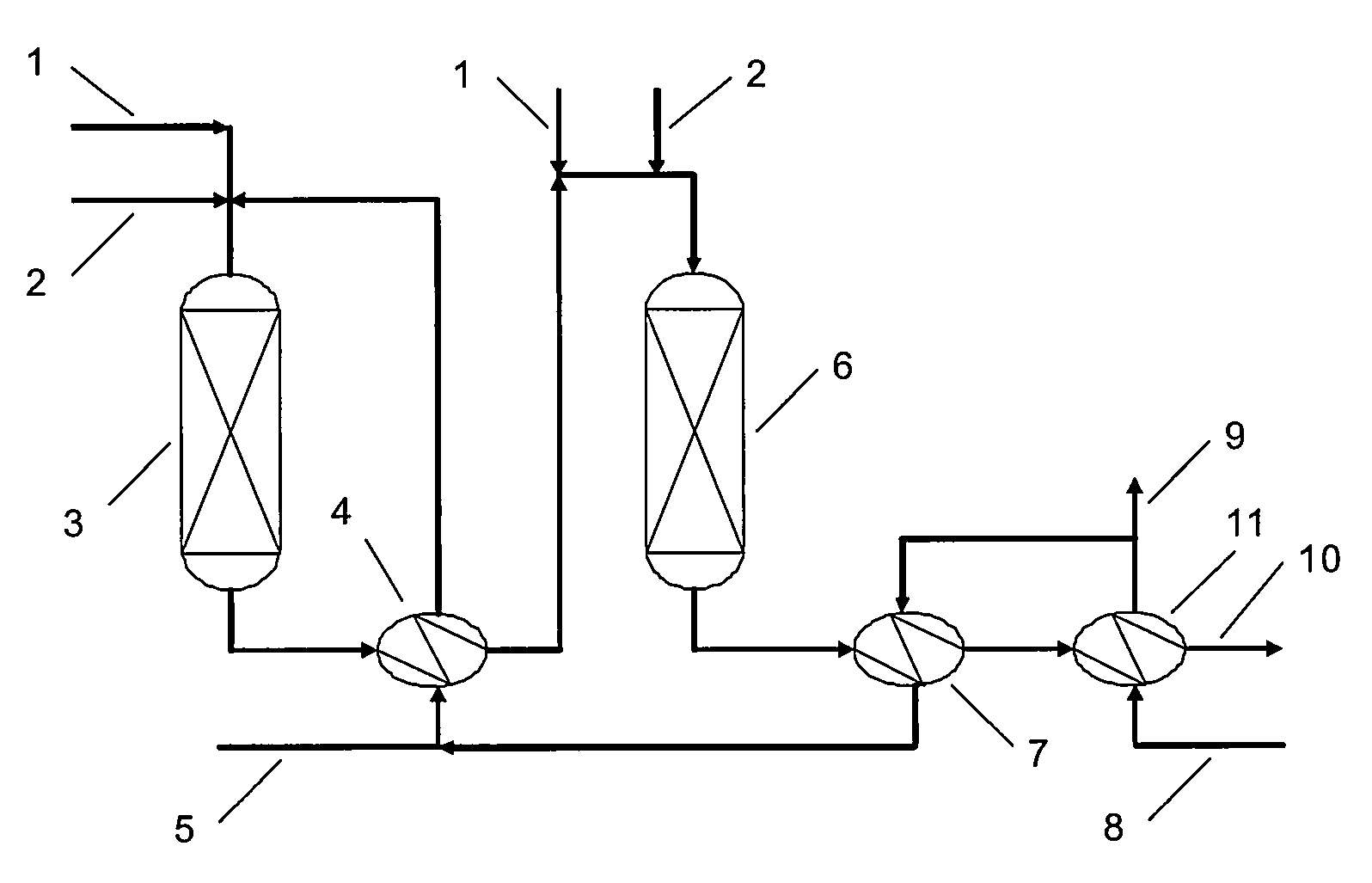Method for producing butadiene through mixing carbon C
A technology for mixing C4 and butadiene, which is applied in chemical instruments and methods, hydrocarbons, hydrocarbons, etc., can solve the problem of low yield of butadiene per pass, high equipment investment and energy consumption, and conversion of butene in one pass. In order to achieve good technical results, reduce energy consumption and waste water discharge, and improve the effect of fluidization
- Summary
- Abstract
- Description
- Claims
- Application Information
AI Technical Summary
Problems solved by technology
Method used
Image
Examples
Embodiment 1
[0043] according to figure 1 As shown, zinc ferrite, calcium ferrite and manganese ferrite co-precipitation catalysts are used, and the catalysts are spherical particles with a particle size of 10-120 microns. The diameter of the fixed fluidized bed reactor is 2.6 meters, and the height is 18 meters; the molar ratio of raw material butene, oxygen, and water vapor is 1:0.67:9.0, and the temperatures of mixed carbon dioxide, air and low-pressure steam after preheating are respectively 260 ℃, the reactor temperature is controlled at 385°C; the quench tower is designed as a two-stage structure, the lower part is an empty tower structure, and the upper part is a sieve plate tower structure; n-hexane is used as the absorbent, and the absorption tower and the desorption tower are designed as a sieve plate tower structure. Experiments have proved that, by adopting the method of the present invention, the single pass conversion rate of butene is 91.3%, and the selectivity to butadiene ...
Embodiment 2
[0045] according to figure 1 As shown, zinc ferrite, calcium ferrite and manganese ferrite co-precipitation catalysts are used, and the catalysts are spherical particles with a particle size of 30-100 microns. The diameter of the fixed fluidized bed reactor is 2.6 meters, and the height is 18 meters; the molar ratio of raw materials butene, oxygen, and water vapor is 1:0.71:9.8, and the temperatures of mixed carbon dioxide, air and low-pressure steam after preheating are respectively 220 ℃, the reactor temperature is controlled at 355°C; the quench tower is designed as a two-stage structure, the lower section is an empty tower structure, and the upper section is a packed tower structure; n-hexane is used as the absorbent, and the absorption tower and the desorption tower are designed as a packed tower structure. The experiment proves that, adopting the method of the present invention, the single pass conversion rate of butene is 90.7%, and the selectivity to butadiene is 96.3%...
Embodiment 3
[0047] according to figure 1 As shown, zinc ferrite, calcium ferrite and manganese ferrite co-precipitation catalysts are used, and the catalysts are spherical particles with a particle size of 60-120 microns. The diameter of the fixed fluidized bed reactor is 2.6 meters, and the height is 18 meters; the molar ratio of raw material butene, oxygen, and water vapor is 1:0.63:8.5, and the temperatures of mixed carbon dioxide, air and low-pressure steam after preheating are respectively 340 ℃, the reactor temperature is controlled at 415°C; the quench tower is designed as a two-stage structure, the lower section is an empty tower structure, and the upper section is an empty tower structure; octane is used as the absorbent, and the absorption tower and the desorption tower are designed as a floating valve tower structure. Experiments have proved that, by adopting the method of the invention, the single pass conversion rate of butene is 90.1%, and the selectivity to butadiene is 97....
PUM
| Property | Measurement | Unit |
|---|---|---|
| particle size | aaaaa | aaaaa |
| diameter | aaaaa | aaaaa |
| height | aaaaa | aaaaa |
Abstract
Description
Claims
Application Information
 Login to View More
Login to View More - R&D
- Intellectual Property
- Life Sciences
- Materials
- Tech Scout
- Unparalleled Data Quality
- Higher Quality Content
- 60% Fewer Hallucinations
Browse by: Latest US Patents, China's latest patents, Technical Efficacy Thesaurus, Application Domain, Technology Topic, Popular Technical Reports.
© 2025 PatSnap. All rights reserved.Legal|Privacy policy|Modern Slavery Act Transparency Statement|Sitemap|About US| Contact US: help@patsnap.com



